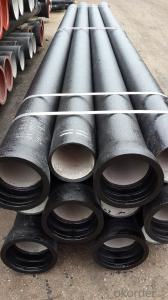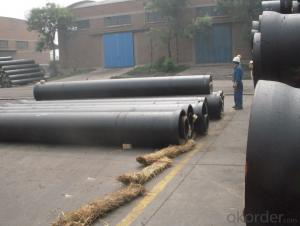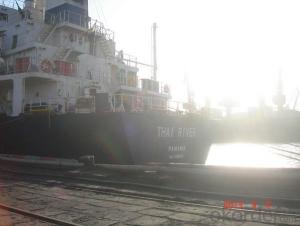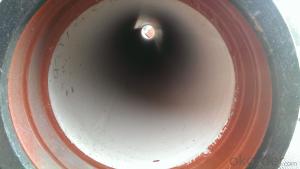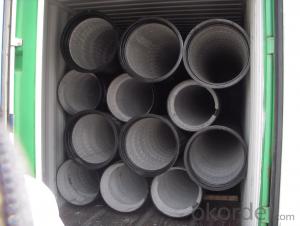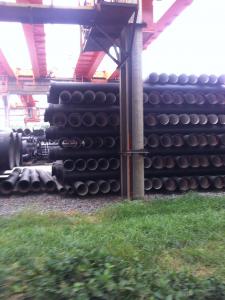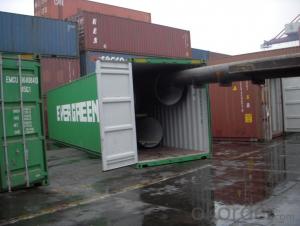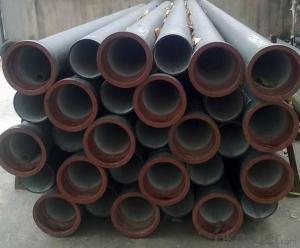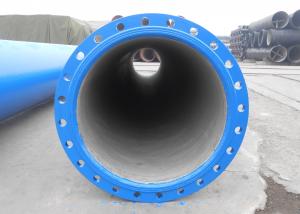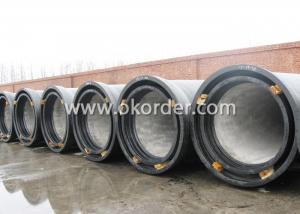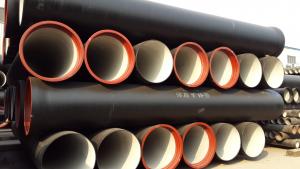DUCTILE IRON PIPES AND PIPE FITTINGS c30 DN500
- Loading Port:
- Tianjin
- Payment Terms:
- TT OR LC
- Min Order Qty:
- 25 m.t
- Supply Capability:
- 30000 m.t/month
OKorder Service Pledge
OKorder Financial Service
You Might Also Like
Material : Ductile Cast Iron
Size Range : DN 80mm to DN 2000mm
Unit Effective Length : 6m or 5.7m
Manufacture Standard: ISO 2531:1998/ EN 545:2006/EN 598:2007
Annual capacity : 200,000 tons
Coating Exterior: Zinc 130g/m2 according to ISO 8179-1 and bitumen coating 70 microns.
Cement Interior: Portland Cement/ High Alumina Cement/ Sulphate Resisting Cement Lining according to ISO 4179
Special requirements on external coating and internal lining can be applied
We also provide accessories such as SBR/EPDM rubber gaskets, lubricant paste, pipe caps, PE sleeves, etc.
Additional Parts:
Each pipe is strictly inspected according to related standard to ensure permanently high performance.
Easy Installation at site and service free for life
Long Service Lifespan
Quotation will arrive you within 24hours once we get your inquiry.
We guarantee offering you a competitive price.
A copy of original inspection reports of pipes will be offered after shipment.
Photos of loading process will be sent to the customer after shipment effect.
We will follow-up the delivery progress after shipment effect and update to the customer on weekly basis.
- Q: How does ductile iron pipe perform in high-temperature environments?
- Due to its unique properties and characteristics, ductile iron pipe performs exceptionally well in high-temperature environments. It is known for its high strength, toughness, and durability, making it suitable for various applications that involve elevated temperatures. One of the main advantages of ductile iron pipe in high-temperature environments is its ability to withstand thermal expansion and contraction. With a low coefficient of thermal expansion, the material can handle significant temperature fluctuations without suffering detrimental effects. This ensures that the pipe remains structurally stable, avoiding deformation or cracking when exposed to high temperatures. Moreover, ductile iron pipe exhibits excellent thermal conductivity, allowing it to efficiently transfer heat. This prevents the accumulation of excessive heat and reduces the risk of thermal stress. Additionally, its high thermal conductivity enables it to dissipate heat quickly, ensuring that the pipe remains within safe operating temperatures. Furthermore, ductile iron pipe has a high melting point of approximately 2200°F (1200°C). This characteristic guarantees that the pipe maintains its structural integrity even in extremely high-temperature environments, making it capable of effectively handling hot fluids, steam, and other substances at elevated temperatures without compromising performance. Another crucial aspect is the corrosion resistance of ductile iron pipe. It is commonly coated with protective linings, such as cement mortar or epoxy, which act as a barrier against corrosion caused by high temperatures. These linings prevent direct contact between the pipe and corrosive substances, thereby ensuring the pipe's longevity in high-temperature environments. In conclusion, ductile iron pipe is an excellent choice for high-temperature environments due to its exceptional strength, thermal stability, thermal conductivity, and corrosion resistance. Its ability to withstand thermal expansion, high melting point, and efficient heat transfer properties make it a reliable and durable option for various applications in such conditions.
- Q: QT400-10 nodular cast iron requires hardness of HRC47~51. Why can't quench hardness be reached?
- Because of the high tempering stability of the nodular iron, the tempering temperature is 400-450 degrees, and the tempering time is 1 hours.
- Q: What are the common methods for leak detection in ductile iron pipes?
- Some common methods for leak detection in ductile iron pipes include visual inspection, acoustic leak detection, pressure testing, and tracer gas leak detection. Visual inspection involves physically inspecting the pipes for any visible signs of leaks, such as water stains or wet spots. Acoustic leak detection uses specialized equipment to listen for sounds of leaking water within the pipes. Pressure testing involves pressurizing the pipes to a certain level and checking for any drop in pressure, which could indicate a leak. Tracer gas leak detection involves injecting a gas, such as helium or hydrogen, into the pipes and using a gas detector to locate any escaping gas, which would indicate a leak.
- Q: Can ductile iron pipes be used for bridge drainage systems?
- Yes, ductile iron pipes can be used for bridge drainage systems. Ductile iron pipes are known for their strength, durability, and resistance to corrosion, making them suitable for various applications, including bridge drainage systems. They can effectively handle the flow of water and withstand the weight and pressure of vehicles passing over the bridge.
- Q: How are ductile iron pipes repaired if they get damaged?
- Ductile iron pipes are repaired in a few different ways depending on the extent of the damage. Here are some common methods for repairing ductile iron pipes: 1. Spot Repair: If the damage is minimal and localized, a spot repair can be carried out. This involves cutting out the damaged section of the pipe and replacing it with a new section. The new section is typically joined to the existing pipe using mechanical couplings or flanged connections. 2. Pipe Lining: In cases where the damage is more extensive but the pipe is still structurally sound, pipe lining can be used. This involves inserting a liner into the damaged pipe, which creates a new smooth surface. The liner can be made of various materials such as epoxy or cured-in-place pipe (CIPP). This method avoids the need for excavation and replacement of the entire pipe. 3. Pipe Bursting: For severely damaged or deteriorated pipes, pipe bursting may be the best option. This process involves pulling a new pipe through the existing damaged pipe, simultaneously fracturing the old pipe and replacing it with a new one. This method is typically used when the existing pipe is beyond repair and needs complete replacement. 4. Welding and Patching: In certain cases, small leaks or cracks in ductile iron pipes can be repaired by welding or patching. Welding involves melting and fusing the metal together to seal the damaged area. Patching, on the other hand, involves applying a specialized epoxy or composite material over the damaged section to create a watertight seal. It is important to note that the repair method used will depend on factors such as the extent of the damage, accessibility to the pipe, and the expertise of the repair crew. In all cases, proper assessment, planning, and execution are crucial to ensure a successful and long-lasting repair.
- Q: How are ductile iron pipes transported and stored?
- Ductile iron pipes are typically transported and stored in a careful manner to ensure their integrity. They are commonly transported by trucks, rail, or waterways, using appropriate handling equipment such as cranes or forklifts. During transportation, they are secured to prevent any damage or movement that could affect their structural integrity. When it comes to storage, ductile iron pipes are usually stacked horizontally on stable surfaces, such as concrete or pallets, to prevent any deformation or bending. They are often stored in covered areas to protect them from weather elements that could cause corrosion or other damages. Additionally, pipes should be stored in a well-ventilated space to prevent moisture accumulation and potential rusting. Regular inspections are also conducted during storage to identify any signs of damage or deterioration. Overall, proper transportation and storage practices are crucial to maintain the quality and longevity of ductile iron pipes.
- Q: What is the average cost of ductile iron pipe?
- The average cost of ductile iron pipe can vary depending on factors such as the size, length, and location. However, as of 2021, the average cost for ductile iron pipe ranges from $10 to $20 per linear foot.
- Q: Are ductile iron pipes suitable for installation in areas with high soil settlement and consolidation?
- Yes, ductile iron pipes are suitable for installation in areas with high soil settlement and consolidation. Ductile iron pipes have high strength and flexibility, allowing them to withstand ground movements without cracking or breaking. They are also resistant to corrosion, which further enhances their suitability for such environments.
- Q: Will the quality of ductile iron shrink?
- I am a professional casting, I can certainly tell you what he said, there is no basis, you see, the concave is due to do not have a good time, where the hot metal supplement
- Q: Can ductile iron pipes be used for marine applications?
- Ductile iron pipes are indeed applicable for marine uses. Renowned for its robustness and durability, ductile iron proves itself suitable for diverse settings, even marine environments. Its remarkable resistance to corrosion empowers it to endure the severe challenges of saltwater exposure. Furthermore, ductile iron pipes have found utility in marine scenarios such as wastewater treatment facilities, desalination plants, and offshore platforms. Nevertheless, it remains crucial to meticulously contemplate appropriate coating and upkeep practices to optimize the lifespan of ductile iron pipes in marine applications.
Send your message to us
DUCTILE IRON PIPES AND PIPE FITTINGS c30 DN500
- Loading Port:
- Tianjin
- Payment Terms:
- TT OR LC
- Min Order Qty:
- 25 m.t
- Supply Capability:
- 30000 m.t/month
OKorder Service Pledge
OKorder Financial Service
Similar products
Hot products
Hot Searches
Related keywords
